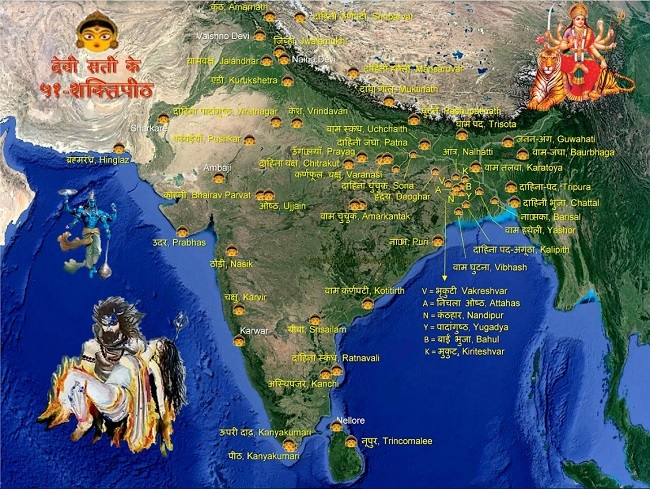Apr 18, 2025
Apr 18, 2025
Shaktipeeths are most revered pilgrim places of Goddess Sati denoting power in Hinduism. As per the legend Lord Brahma’s son and king of Himalaya, Daksh Prajapati once performed yagya at Prayagraj. He did not invite her daughter Sati (incarnation of Adi-Shakti) as She married Mahadev Shiv against father’s will. In spite of discouragement from Lord Shiva, Sati came to attend yagya; but did not get a treatment she expected. When Daksh insulted Mahadev, Her husband, Sati felt so bad that She immolated herself then and there. Shivjee came and took Sati’s body, and out of grief and anger He started moving in the sky. To relieve Him from grief Shri Vishnu came and with his Sudarshan Chakra fragmented Sati’s body. Wherever Sati’s ornaments and body parts fell on the earth/ ground, those places became the Satipeeths or Shaktipeeths. In addition to Maa Shakti, Bhairav/ Kaal Bhairav are present at each site. These sacred places of Goddess Sati are worshipped as personification of power, sacrifice for love, devotion and resurgence.
Our ancient sacred scriptures indicate 4 Adi-Shaktipeeths or Tantra-Peeths (Sri Vimala, Taratarini, Kamakhya and Kali), 18 Maha-Shaktipeeths, and 51 Shaktipeeths. Adi Shankaracharya mentioned 18 Shaktipeeths. Main literature for Shaktipeeths includes Kalika Puran, Devi Bhagvat Puran, Shiva Charitra, Tantra Chudamani, Mahapitha Puran, Yogini Tantra, and Brahmand Puran. Some of these show 108 Shaktipeeths; locations of a few are uncertain.

Searching an authentic list of 51 Shaktipeeths at internet resulted in confusion and mismatch with many sites. Not even two sites, mostly for tourism, show the same list, which I felt disturbing. Some sites under ’51-Shaktipeeths’ described more Shaktipeeths. Only a few compilations appear satisfactory i.e. D.C. Sircar, book 1973; RPB Singh, paper 2002; compilation by P.K. Hari and Indian Spiritual Encyclopedia. Shaktipeeths listed by geography Professor RPB Singh, BHU are the following:
The Amaranath, Attahasa, Bahula, Batanagar, Baurbhaga, Bhairav Parvat, Chattal, Deoghar, Gandaki, Hinglaz, Jalandhar, Janasthan, Jvalamukhi, Kalamadhav, Kalipith, Kamakhya, Kanchi, Kanyakumari, Karatoya, Karvira, Kotitirtha, Kurukshetra, Manas, Manivedika, Nalhatti, Nandipur, Nellore, Panchasagar, Pashupatinath, Patna, Prabhas, Prayag, Puri, Ramagiri, Ratnavali, Shri Parvat, Shrishailam, Sona, Suchindram, Sugandha, Tripura, Trisota, Uchchhaith, Ujjaiyini, Vaktreshvar, Varanasi, Vibhash, Virat, Vrindavan, Yashor and Yugadya.
However, Singh’s compilation too showed some anomalies. Nellore in Sri Lanka is with question mark; Prabhas and Uchchhaith locations are incorrect. Hinglaz peeth shown as 250 km west of Karachi is actually 170 km NW. Panchasagar is not at Karwar; it is at Varanasi. Sona is at Sasaram but in map it is at Amarkantak. Ratnavali is at Chennai and Kankhal. Some websites have added Chhatarpur, Danteshwari, Karnat, Naina Devi, Sharkrare and Vajrakshetra in 51-Shaktipeeths. Websites show more than one location for Sati’s eyes (Kolhapur/ Naina Devi), navel (Utkal/ Puri) and heart (Ambaji/ Deoghar). Nellore and Trinkomalee are for anklet, while Kanchi in TN and Bolpur in WB are for Skelton. Kiriteshwari and Batanagar are meant for the crown of Goddess Sati.
Out of these, Manas is at Mansarovar, in Tibet; Hinglaz in Pakistan; Gandaki and Pashupatinath in Nepal; Shankari in Sri Lanka; Chattal, Karatoya, Sugandha and Yashor in Bangladesh.
I tried to locate a map having all 51-Shaktipeeths on internet; the available ones, however, I found either clumsy in locations or show >51 sites including that of Wikipedia.
Using RSB Singh’s list I identified and marked all 51-Shaktipeeths on Google Earth image and produced the attached map. After cross-checking from the literature I could add the part of Goddess Sati fell at each location; preferred labeling in Hindi as most maps are in English. Hope it will be of interest to those who have faith in Devi Sati.
01-Oct-2022
More by : Dr. Ashok Grover